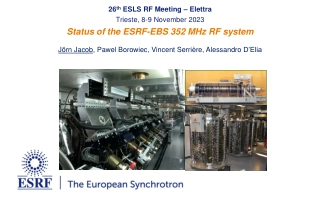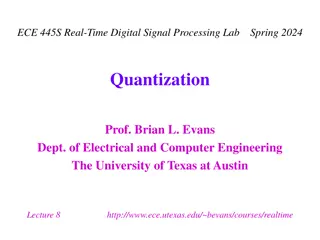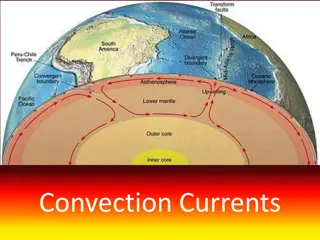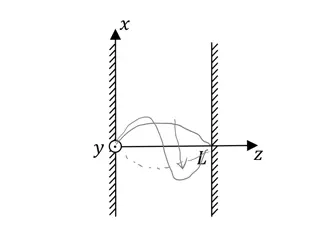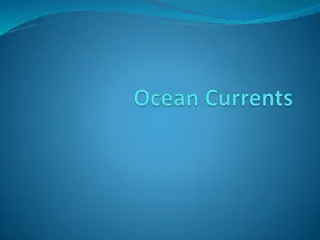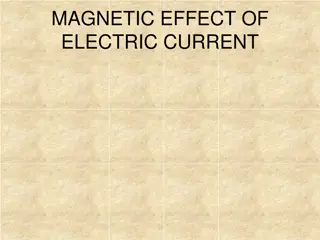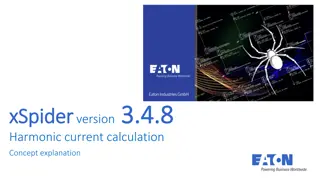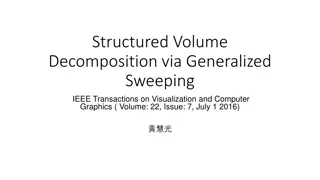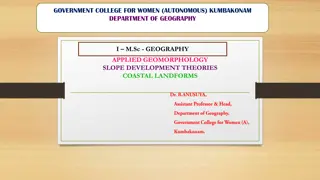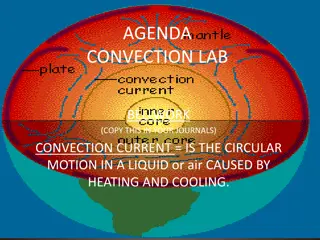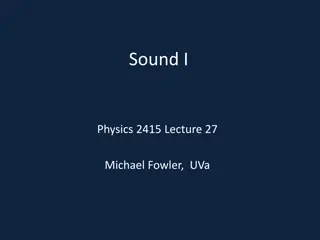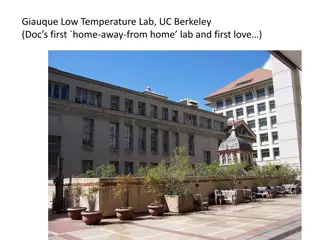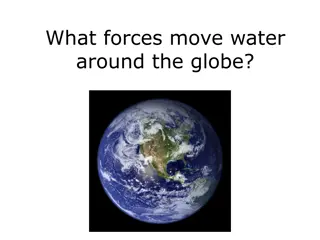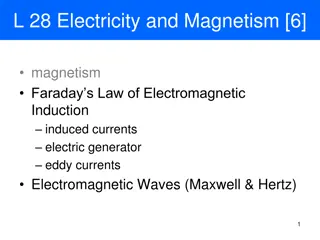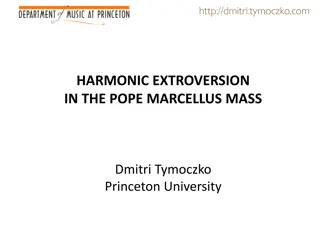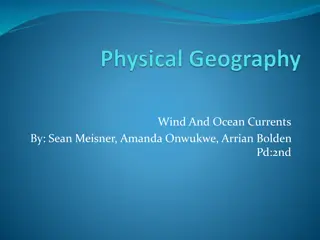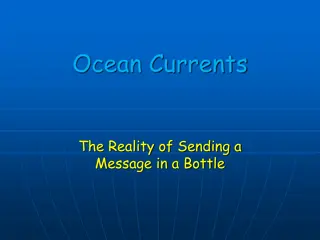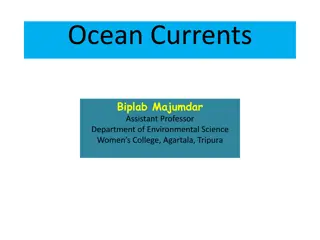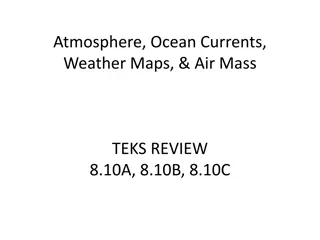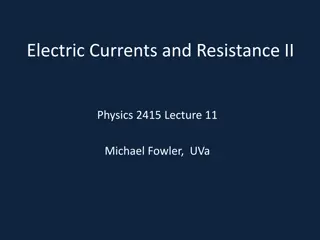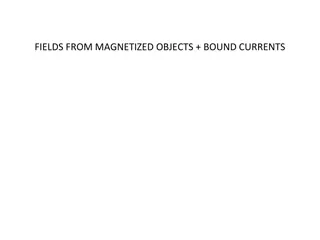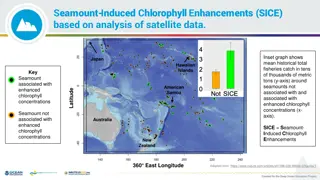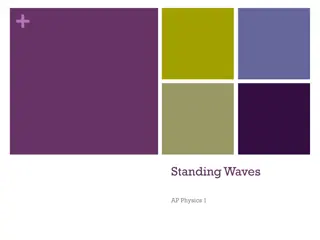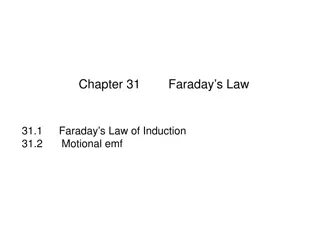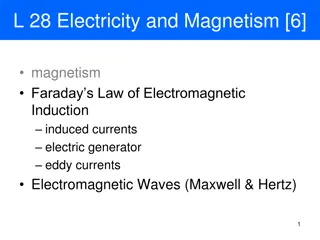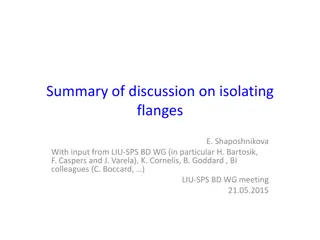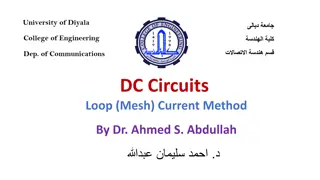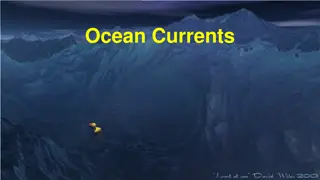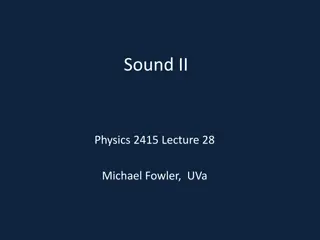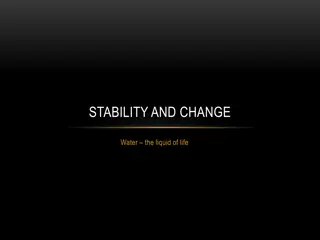Overview of ESRF-EBS 352 MHz RF System Upgrade at 26th ESL RF Meeting
The 26th ESL RF Meeting held at Elettra in Trieste discussed the status and upgrades of the ESRF-EBS 352 MHz RF system. The meeting covered topics such as the EBS RF layout, HOM damped cavities, RF ECO-Mode, ongoing RF projects, and the replacement of klystrons with SSAs for a 4th harmonic RF system
0 views • 16 slides
Real-Time Digital Signal Processing Lab: Quantization and Resolution Overview
Explore quantization and resolution techniques in real-time digital signal processing. Topics include quantization error analysis, total harmonic distortion, noise immunity in communication systems, human sensory resolution, analog-to-digital conversion, and uniform amplitude quantization. Dive into
7 views • 19 slides
Understanding Convection Currents in Earth's Systems
Convection currents refer to the movement of heat by fluids like liquids and gases, transferring heat from one place to another. They play a significant role in the geosphere, atmosphere, and hydrosphere of the Earth, influencing phenomena such as plate tectonics, winds, and ocean currents. In the g
0 views • 12 slides
Understanding Quantum Aspects of Electromagnetic Oscillations
Exploring the quantum nature of electromagnetic oscillations through concepts such as wave-particle duality, quantum harmonic oscillators, photon-number states, coherent light, and squeezed light. Delve into non-classical states, vacuum states, potential wells, and more in the fascinating world of q
0 views • 15 slides
Innovative Three-Phase Voltage Measurement Transformer Design
This paper introduces a novel three-phase dry-type voltage measurement transformer utilizing triangular cores for enhanced efficiency and reduced losses. By optimizing core design, the transformer aims to save space, decrease harmonic content, and increase energy efficiency. The study includes model
1 views • 16 slides
Designing Low-Pass Filter for Square Wave Harmonic Suppression
This tutorial discusses the design of a low-pass filter to suppress harmonics in the output of a square wave signal. The goal is to achieve at least 32 dB attenuation of any harmonics relative to the fundamental sinusoid at 5 kHz. The solution involves analyzing the square wave, determining the nece
0 views • 18 slides
Understanding Ocean Currents and Effects
Ocean currents play a crucial role in the movement of water across the Earth's surface. Wind-driven surface currents, influenced by the Coriolis effect, move water horizontally and impact climate patterns worldwide. Major currents extend deep below the surface and can move rapidly, while rip current
0 views • 14 slides
Exploring Neural Quantum States and Symmetries in Quantum Mechanics
This article delves into the intricacies of anti-symmetrized neural quantum states and the application of neural networks in solving for the ground-state wave function of atomic nuclei. It discusses the setup using the Rayleigh-Ritz variational principle, neural quantum states (NQSs), variational pa
0 views • 15 slides
Revolutionizing DC Circuits with Phaseback DC Choke: A Unique Electromagnetic Filter
Phaseback DC Choke, a patented product by Applied Energy LLC, offers complete voltage smoothing and AC harmonic filtering for DC circuits of all sizes. Unlike traditional chokes, it utilizes mutual counter-electromagnetic inductance for superior AC noise reduction without heating the core. This inno
0 views • 12 slides
Exploring the Magnetic Effect of Electric Current
Understanding electromagnetism involves recognizing how an electric current in a conductor generates a magnetic field around it. This phenomenon was first observed by Hans Ørsted in 1820, leading to discoveries about magnetic field patterns for various conductor shapes. By studying straight wires,
0 views • 30 slides
Understanding Harmonic Current Calculation in Electrical Systems
Explore the concepts of harmonic current calculation in electrical systems with a focus on xSpider version 3.4. Learn about the influence of harmonics on line dimensioning, effects of nonlinear loads, and the importance of estimating THDi for proper line dimensioning. Discover how frequency inverter
0 views • 9 slides
Understanding Electrode Reactions in Electrochemistry
Exploring electrode reactions in electrochemistry involves delving into Faraday's law, coulometry, and the importance of sustainable electrode reactions. These concepts help us understand how the quantity of charge passed affects the production or consumption of substances in electrode reactions. As
4 views • 27 slides
Exploring Song Structure and Arrangement in Music Education
Delve into the intricacies of song structure and arrangement with this resource pack designed for Year 7 and 8 music students. From defining song concepts to experimenting with musical texture, harmonic ideas, and more, students will learn to lay the foundations for creating captivating songs. Engag
0 views • 12 slides
Structured Volume Decomposition via Generalized Sweeping
This paper introduces a new technique for generating a simple and predictable structured hex-mesh, providing better convergence properties and more space efficiency in computer graphics and engineering applications. The method involves computing 3D harmonic function decomposition, slicing the object
0 views • 30 slides
Understanding Coastal Landforms: Formation and Characteristics
Coastal landforms are features shaped by erosion and sedimentation processes along coastlines. These landforms, including headlands, cliffs, bays, spits, salt marshes, and beaches, are predominantly influenced by factors such as wave action, longshore currents, tides, and climatic elements like wind
0 views • 35 slides
Explore Convection Currents Lab Activity
Engage students in a hands-on lab activity to observe convection currents in action. The agenda includes bell work about convection, a hypothesis on confetti paper movement in hot water, detailed lab procedures, drawing conclusions with CER format, and thought-provoking conclusion questions related
0 views • 7 slides
Understanding Sound Waves: Exploring Wave Phenomena in Physics
Delve into the intricacies of sound waves in Physics with a focus on standing waves, boundary conditions, amplitude variations, and wave interactions. Explore concepts like harmonic wave addition, pulse encounters, and outcomes at fixed and free ends of a string. Discover how different scenarios aff
0 views • 22 slides
Journey Through Science: Labs, Spectra, and Mentors
Explore a visual journey through various scientific labs, equipment, and notable personalities in the field of chemistry, including Giauque Low Temperature Lab at UC Berkeley, advanced measuring systems, and insights into the lives of renowned scientists like E. Bright Wilson and Doc Fong. Witness t
0 views • 13 slides
Forces Driving Ocean Currents and Water Movement Explained
Explore the forces behind water movement across the globe, including the impact of wind on surface currents and the role of temperature and density in driving deep ocean currents. Discover how cold, dense water sinks while warm, less dense water rises, influencing the circulation of water in our oce
0 views • 21 slides
Understanding Magnetism: Faraday's Law and Induction
Explore the fundamental concepts of magnetism, including Oersted's and Ampere's discoveries, Faraday's Law of Electromagnetic Induction, and the generation of induced currents. Delve into the interplay between magnetic fields and currents as elucidated by Michael Faraday, and learn how changing magn
0 views • 24 slides
Analysis of Harmonic Tendency in Pope Marcellus Mass by Dmitri Tymoczko
Arguing the gradual development of functional harmony from 1500-1700 and beyond, Tymoczko discusses the influence of Ionian-mode music and the extroverted polyphony in the celebrated Pope Marcellus Mass. Delving into the harmonic character and interpretive challenges of the piece, he explores the 6.
0 views • 20 slides
Understanding Wind and Ocean Currents: Influence on Weather and Climate
Wind is caused by air moving across the Earth's surface due to uneven heating by sunlight, impacting weather patterns. The interaction of wind and water leads to various weather phenomena like precipitation, influenced by factors such as the El Niño phenomenon. Ocean currents, driven by wind, play
0 views • 12 slides
Understanding Ocean Currents: Causes and Effects
Explore the fascinating world of ocean currents and how factors like temperature, wind, Earth's rotation, and gravity influence their movement. Learn about the impact of ocean water properties on currents, the distribution of surface temperatures, and the role of various forces like solar heating, w
0 views • 19 slides
Understanding Ocean Currents and Their Impact
Dive into the world of ocean currents with Assistant Professor Biplab Majumdar as he explores the different types of currents, such as surface and deep water currents. Discover how surface currents are influenced by factors like global wind patterns, the Coriolis effect, and continental deflections,
0 views • 19 slides
Understanding Global Ecosystems and Climate Influences
Global ecosystems are defined by dominant vegetation types and are influenced by factors like climate, atmospheric circulation, altitude, relief, and ocean currents. The distribution and characteristics of ecosystems are shaped by global atmospheric circulation patterns, creating distinct belts of v
0 views • 18 slides
True or False Review - Ocean Currents and Climate Dynamics Quiz
Test your knowledge on ocean currents, climate dynamics, and related phenomena with this engaging true or false review game. Explore concepts such as the influence of global winds on surface currents, the Coriolis effect, the Gulf Stream, deep ocean currents, El Nino events, and more. Challenge your
0 views • 43 slides
Atmosphere, Ocean Currents, Weather Maps, & Air Mass TEKS Review
Explore key concepts related to atmosphere, ocean currents, weather maps, and air mass in this TEKS review. Understand the factors contributing to Earth's uneven heating, the role of convection in ocean currents, the energy sources that drive ocean convection, and the effects of heating on air densi
0 views • 21 slides
Understanding Electric Currents and Resistance II in Physics
Capacitors, resistance, energy usage, and the microscopic picture of conductivity are explored in this lecture on electric currents and resistance II in Physics 2415. Discover the relationship between voltage, charge, current, and resistance, along with insights into power usage, resistivity, and th
0 views • 22 slides
Understand Magnetic Fields and Currents in Solids
Explore the concepts of magnetic fields and currents in solids, including the calculation of magnetic dipole moments, the presence of bound currents in cylinders with uniform magnetization, the distribution of bound currents on different surfaces, and the behavior of magnetic fields in solid cylinde
0 views • 14 slides
Insights into Seamount-Induced Chlorophyll Enhancements and Currents
Study explores the impact of seamounts on chlorophyll concentrations and fisheries catch, as well as the measurement of ocean currents using arrays of current meters. Additionally, the biophysical drivers influencing Seamount-Induced Chlorophyll Enhancements (SICE) are investigated using geophysical
0 views • 4 slides
Understanding Standing Waves in Physics
Standing waves in physics are periodic waves that result from the interference of reflected and inverted waves, creating nodes and antinodes along a medium. These standing wave patterns can be observed in vibrating strings, such as guitar strings, where specific frequencies produce distinct harmonic
0 views • 29 slides
Understanding Faraday's Law of Induction and Lenz's Law
Faraday's Law of Induction states that a changing magnetic field induces an electromotive force (emf) in a conductor, producing an induced current. Lenz's Law complements this by determining the direction of the induced current to oppose the change in magnetic field. This phenomenon is demonstrated
0 views • 23 slides
Understanding Magnetism: Faraday's Law and Electromagnetic Induction
Explore the fascinating world of magnetism and electromagnetism with insights into Faraday's Law of Electromagnetic Induction, induced currents, and the basic principles of magnetism. Discover how a changing magnetic field can produce a current and unravel the key concepts behind electromagnetic wav
0 views • 24 slides
Beating the Harmonic Lower Bound for Online Bin Packing - Strategies and Results
Explore the strategies and results in online bin packing as presented by Sandy Heydrich and Rob van Stee. The discussion delves into competitive ratios, known upper and lower bounds, the HARMONIC algorithm, and improvements such as the SUPERHARMONIC concept. Discover the challenges and optimizations
0 views • 24 slides
Discussion on Isolating Flanges in SPS Impedance Model
Discussing the installation and impact of insulating flanges in the SPS, particularly on eddy currents and resonance effects. The presence of isolated flanges to prevent eddy currents in grounding loops is analyzed, along with potential enhancements in dynamic effects. Preliminary measurements and m
0 views • 11 slides
Understanding Electric Currents and Charge Continuity
Explore the concepts of electric currents, charge continuity, volume current density, surface current density, and more through a series of questions and visuals. From understanding the flow of ions in a liquid to calculating current densities in wires, this content delves into essential principles
0 views • 10 slides
Understanding DC Circuits: Mesh Current Method by Dr. Ahmed S. Abdullah
The DC Circuits Loop (Mesh) Current Method, explained by Dr. Ahmed S. Abdullah, applies Kirchhoff's Voltage Law (KVL) to find unknown currents in a circuit. This method involves assigning loop currents to loops, applying KVL to each loop, and indicating voltage polarities across all resistors based
0 views • 31 slides
The Importance of Ocean Currents in Global Systems
Ocean currents play a vital role in transporting heat, nutrients, organisms, and influencing weather patterns and climates. They impact commerce, gas exchanges, nutrient exchanges, pollution dispersal, and fisheries. The interaction between surface and deep-sea currents forms the global ocean convey
0 views • 25 slides
Understanding Sound Waves: Harmonic Vibrations and Longitudinal Waves
Exploring the concepts of harmonic string vibrations in musical instruments, longitudinal waves in pipes, boundary conditions at pipe open ends, and the wave equation for waves in two and three dimensions. Topics include interference, Doppler effect, and wavelength calculations for standing harmonic
0 views • 19 slides
Exploring the Vital Role of Water in the Water Cycle and Ocean Currents
Water, the essence of life, plays a crucial role in our ecosystem through the water cycle. From evaporation to condensation, and precipitation, water moves between states, sustaining life and influencing weather patterns. Additionally, ocean currents drive the movement of water worldwide, impacting
0 views • 16 slides
